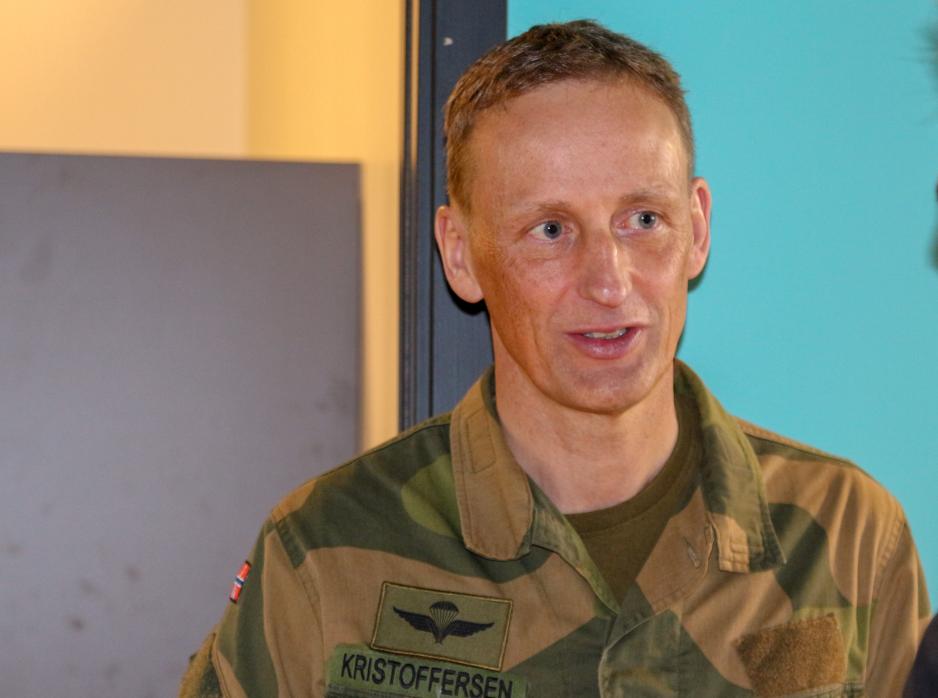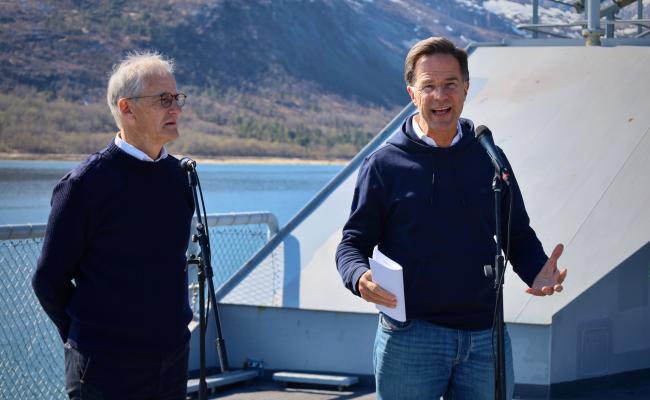“Norway Must Be the One to Have Control in the Areas Closest to Russia”

Norway's Chief of Defense, Eirik Kristoffersen, at the Kirkenes Conference 2025. He firmly rejects Trump's ideas about taking over Greenland. "The US will not make military advances against Greenland. We are allies and cooperative partners, and married, so to speak," said the defense chief during a debate. (Photo: Trine Jonassen)
Kirkenes (High North News): Russia is rattling its sabers along NATO's borders in the North, and the Norwegian prime minister warns against war and opens up for increased allied exercises in the High North. But both Norway's PM and Chief of Defense Eirik Kristoffersen trust Trump to respect Norwegian game rules.
Norway and Finland are the only Nordic NATO countries to share a border with Russia, at 200 and 1,340 kilometers, respectively.
Satellite photos recently published by the New York Times showed the Russian expansion of military infrastructure along the Finnish border.
There are reports of several rows of tens, military vehicles, maintenance and modernization of fighter jet shelters, and the development of a formerly inactive helicopter base.
Swedish SVT reports of several helicopters at the Severomorsk-2 military base, located 180 kilometers from the Finnish border and 110 kilometers from the Norwegian border in Eastern Finnmark.
Severely weakened
Defense chief Eirik Kristoffersen reassures that Russia is still severely weakened by the war in Ukraine, and that it would take between three to ten years to rearm in the North, "depending on who you ask."
There must be Norwegian capacities, soldiers, aircraft, and vessels that have control in the areas closest to Russia.
Last week, Norwegian PM Jonas Gahr Støre (Labor) announced increased allied exercises in the North. He calls it "adjustments of boundaries," which in practice entails pushing against the self-imposed boundary for allied exercises along the border with Russia.
"Norway has decided to adjust its guidelines for military activity in Finnmark to facilitate increased exercise and cooperation with Sweden and Finland," a press release reads.
"This is not a notice about incoming activities and exercises along the border with Russia," maintains the prime minister to High North News when we meet him in Kirkenes, 100 kilometers from Russia's strategic nuclear weapons.
Norwegian leadership
It is nevertheless all reason to take Russia seriously.
How does the Norwegian Armed Forces meet the increased Russian activity?
"There must be Norwegian capacities, soldiers, aircraft, and vessels that have control in the areas closest to Russia. These are very sensitive and strategically important areas for Norway, Russia, and NATO, and thus, we must have Norwegian capacities there. Therefore, we are building up the Finnmark Brigade," said Kristoffersen to High North News in Kirkenes.
Alongside the chiefs of defense from Finland, Sweden, and Denmark, Kristoffersen took part in the debate about security in the North at the Kirkenes Conference.

The 24th meridian east boundary as we know it. Until now, Norway could exercise beyond the meridian, but not NATO. (Google maps)
What is currently the Finnmark land defense is to be developed into the Finnmark Brigade. The new brigade will become a standing force that can operate independently over time.
In addition, the Armed Forces is investing in new submarines with the first delivery scheduled for 2029, five maritime patrol aircraft are already in action at Evenes Air Station, and the Intelligence Service has been given responsibility for the Armed Forces' space operations. In all, this contributes to a better situational understanding.
Urgent
"At the same time, we see that Russia has plans to strengthen its defense. Therefore, what we are doing is significant nationally, but also seen from a Nordic framework and a NATO perspective going forward."
How acute is the activity and threat along the border with Russia?
"Right now, Russia is weakened because they have moved so many forces to Ukraine and suffered great losses. The question, then, is how long it will take Russia to rebuild after the fighting in Ukraine eventually stops. The estimates vary from three to ten years. To me, it is urgent to strengthen the Armed Forces, particularly in the North. Thus, developing the new brigade and getting new vessels for the Navy, which will take some time, is facing the future."
Also read (the article continues below)
Taken seriously
In the wake of Russia's attack on Ukraine, there was a consensus that we were not prepared for war. Are we prepared now?
"We are better prepared than we have been. Then we must rectify all the gaps that exist in the Norwegian defense to further improve it. We have just received a report from the National Audit Office of Norway stating that we need to prepare the total defense more effectively. We must take that seriously."
The Norwegian PM talks about increased allied activity in the North. How does that challenge Russia?
"I am a supporter of clear guidelines regarding activity close to the border with Russia, so there will be Norwegian soldiers patrolling the border, Norwegian vessels sailing with allies in the ocean areas here, and we will have Norwegian surveillance capacities. However, we will also do it in close coordination with our allies. Because it is together with allies in the Nordic region and NATO that we deter Russia and prevent war."
He is clear that Norway is the one to ultimately be left with a neighborship with a belligerent state.
"Norway must have a say because we who live here are left with the relationship with Russia, also after the allies have left an exercise. Therefore, we must have good control and strengthen the Norwegian defense in Norway."
Predictable, stable and no surprises.
Further east
When Støre heralds increased allied activity in the North, it implies that the "24th meridian boundary", which is about Norway's desire to limit NATO's military presence near the border with Russia, is in practice being discarded.
The scheme dates back to the 1950s, and Kristoffersen has previously argued that the boundary should be placed further east than it is today, as the military bases of Porsangermoen and Banak are located to the east of it.
Now, Norway is opening up to letting NATO exercise further east toward the Russian border than previously.
"We are not revealing the details of it, but these are decisions Norway makes to have good and efficient exercises with our allies in a continuation of what Norway has done; keeping it predictable, stable, and with no surprises."
East in the Barents Sea
"The new guidelines allow NATO to exercise further east than the 24th meridian, which applied a few years ago," said Kristoffersen.
Nordic defense chiefs at the Kirkenes Conference 2025. From the left, moderator Siri Lill Mannes, General Janne Jaakkola (Finland), General Michael Wiggers Hyldgaard (Denmark), Lt. General Carl-Johan Edström (Sweden), and General Eirik Kristoffersen (Norway). (Photo: Trine Jonassen)
How further east?
"That will depend on what is to be practiced and exercised. For example, aircraft are flying further east than the 24th meridian in the Barents Sea."
Respected by Trump?
Does Trump respect Norway's rules in the North?
"USA respects this and is good at coordinating with us when they have activities in the High North. We also want more allied activity with the USA, France, the UK, and Germany, as examples of nations that are also sailing further north than before, and that contribute to Norwegian security."
Also read (the article continues below)
Prime Minister Jonas Gahr Støre, is there a risk in providing the US President, Donald Trump, with increased access to Norway's Arctic areas through increased allied exercises in the North?
"That is a very distant issue. We have allied training in Norway with allies from Europe and the USA who train with us across the entire country, as well as in the North. And there will not be any more or less of it, but there will be an adjustment of the boundaries to correspond to the situation we have now, with Finland and Sweden as neighbors in NATO."
So you see no increased threat from an unstable Trump?
"No, the bilateral allied cooperation we have with the USA in the North revolves a lot around keeping watch on the military development in the North, and that will continue. And there are some very well-established routines for that," says Støre to HNN.
Professionally in the North
So far, Kristoffersen believes the situation in the North to be stable.
We are mostly facing hybrid threats.
"We must have the ability to be out with Norwegian vessels where possible, and we must be good at coordinating with allies. However, we still encounter Russian vessels, and the Border Guard acts professionally and respectfully when meeting Norwegian forces; we must take that into consideration going forward. The war in Ukraine is entirely unacceptable. At the same time, we see that there is still a professional behavior in the Nordic region."
The prime minister confirms this.
"We are primarily facing hybrid threats. The line between what was considered war and, for example, sabotage or other activities has blurred. We must be honest about that, and one of the threats we're facing is war. But I have been at the border and met the patrols along the border, and we do not see that we are facing a military threat in the North today."
Can increase the risk
What response has Russia had to the announcement of increased military activity in the North?
"I have not heard anything about that, but it is usual for Russia to protest against all such statements from Norway. But I repeat, we decide how to conduct our activity in Norway. It will take place in a way that does not provoke or concern others, but that is the right every country has," says Støre.
"The current threat is what is called hybrid warfare, such as attacks on energy and water supplies. So, we must be honest and discuss it thoroughly to prepare for the possibility that it could happen to us. We are not threatening anyone, but it is our responsibility to ensure that no one can be threatened," concludes PM Støre.
To the Russian news agency Ria Novosti, the Russian Embassy in Norway has warned that a lack of trust and communication in the military area between Russia and NATO could increase the risk of "dangerous incidents."
"We are convinced that intensive militarization of Norwegian northern areas will not lead to increased security, but on the contrary, increase military-political tension and the risk of escalation in the Arctic," stated the embassy.




